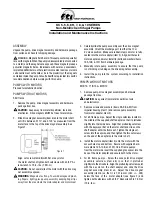
8
Issue 13 (11/14/2017)
for as long as available battery power will allow. The Major Alarm display will list "Sleep Mode Fault" along
with any other alarm conditions.
If there is voltage on the line that is not within the published specifications the power supply will attempt to
maintain the output voltage but will not come out of Sleep Mode or charge the batteries until the line voltage
returns to the approved range. When the line voltage returns to the specified range, the power supply will
switch to Line Mode and after a delay will terminate Sleep Mode and attempt to charge the battery and return
to normal operation. If battery voltage cannot be raised above the nominal battery voltage (36 or 48 VDC) the
power supply will not function in Standby (Inverter) Mode.
Battery Test/Self Test:
The EB1s is capable of performing a battery test. The test mode forces the power supply into battery pow-
er/inverter mode. The test can be initiated locally through the front panel, remotely through the status monitor-
ing interface, or self initiated. If the battery string voltage falls to the programmed shutdown voltage during the
test an alarm is set indicating “Battery Test Failed” and must be cleared through the LCD display. This alarm is
also reported through the status monitoring interface.
Self Test:
The Self Test period is programmable in the Configuration Menu for 14 or 28 days. The Self Test
may also be disabled in the Configuration Menu.
The duration of a test is determined by the Test Duration pro-
grammed in the Configuration menu and may be set from 1 to 60 minutes.
For a test cycle to be initiated, the
battery string voltage must be over 36 VDC for a 36 volt system or 48 VDC for a 48 volt system.
Local Test:
The local test is initiated through the front panel.
The duration of a test is determined by the Test
Duration programmed in the Configuration menu and may be set from 1 to 60 minutes.
For a test cycle to be
initiated, the battery string voltage must be over 36 VDC for a 36 volt system or 48 VDC for a 48 volt system.
Remote Test:
The remote test is initiated through the status monitoring interface. The duration of a test is de-
termined by the Test Duration parameter programmed in the Configuration menu and may be set from 1 to 60
minutes. In addition, a Remote Test can be configured to run for an unlimited time, stopping only when halted
manually or due to a test fail or power line failure.
See Remote Test Time in the Configuration section of this
manual.
For a test cycle to be initiated, the battery string voltage must be over 36 VDC for a 36 volt system or
48 VDC for a 48 volt system.
Status Monitoring Interface:
The EB1s may be equipped with one of several embedded status monitoring options. An external transponder
supporting the ANSI/SCTE 25-3 2002 standard of status monitoring may also be used.
Embedded Transponder:
Embedded transponders are available from Electroline, Phoenix Broadband, and
Cheetah
Technologies. Refer to the transponder manufacturer’s documentation for installation and operation
instructions.
External Transponder:
The SERIAL connector located on the front panel meets the ANSI/SCTE 25-3 2002
standard for status monitoring. Power to the transponder is provided through the SERIAL connector. The pow-
er on the SERIAL connector is NOT available if the battery string voltage is less than 31.5VDC.
A standard “straight through” CAT-5 type cable can be used to connect the SERIAL connector to the tran-
sponder.
The SERIAL connector must never be connected to an ETHERNET port.
Damage may occur to
both the power supply and the transponder.
SERIAL Connector Pin Assignments
Pins 1 & 8, Ground
Pins 2 & 7, +24 VDC ± 15% at 200mA
Pins 3 & 6, RS-485 (+)
Pins 4 & 5, RS-485 (-)
Refer to the transponder manufacturer’s documentation for installation and operation instructions
.
Summary of Contents for EB1s
Page 2: ......
Page 35: ...33 Issue 13 11 14 2017 Fig 8 1 Battery Balancer wiring 36V 3 batteries 1 string ...
Page 36: ...34 Issue 13 11 14 2017 Fig 8 2 Battery Balancer wiring 48V 4 batteries 1 string ...
Page 37: ...35 Issue 13 11 14 2017 Fig 8 3 Battery Balancer wiring 36V 6 batteries 2 strings ...
Page 38: ...36 Issue 13 11 14 2017 Fig 8 4 Battery Balancer wiring 48V 8 batteries 2 strings ...











































